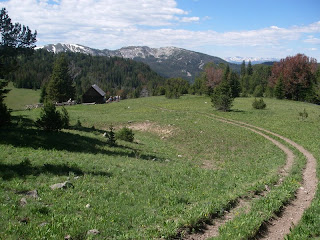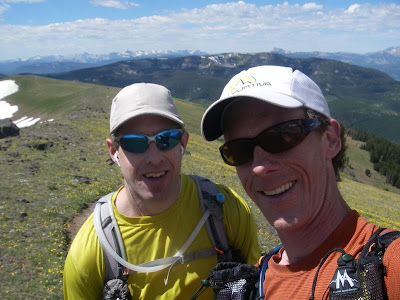Tom McGoff Hayes confirmed our entries and told us that "this is not a normal trail run. You will be carrying more weight since you will need food and water for at least 5 hours (more likely eight to ten hours) until the one and only aid station. You will also have to feel confident navigating mountain ridges and meadows with no ribbon showing the way... This definitely should not be your first 50 miler." Not to mention, most of the trail was higher than 9000 ft above sea level, making it even more difficult for us low-landers.
Chase and I drove out together to Bozeman on Thursday and crashed in the living room of his friend Peter for the long weekend; Peter also graciously provided us with a beaten up old tandem bike to ride around town so that we could take in the sights. The sun beat down on us with temperatures above 90; Saturday was going to be a little cooler, however. I tried my best not to burn to a crisp before then.
We attended the pre-race meeting on Friday in Tom's backyard, where I sized up the competition. Two guys from Utah, Jay Aldous and Leland Barker, had both finished in the top 5 at Hardrock in previous years, and were the contenders to win. Another runner, Christian Johnson, had run Devils Backbone last year in 10:30, which was my goal for running this year, so I thought I should watch for him and try to tuck in behind him.
 Tom gave away a bunch of prizes from sponsors to all the attendees, fed us a pasta dinner, and gave us a few pointers about where we could go wrong on the totally unmarked course the next day. He provided some hand-drawn maps as well that showed key turns; I also had topo maps that I had printed out from his website, so I felt pretty confident about staying on route.
Tom gave away a bunch of prizes from sponsors to all the attendees, fed us a pasta dinner, and gave us a few pointers about where we could go wrong on the totally unmarked course the next day. He provided some hand-drawn maps as well that showed key turns; I also had topo maps that I had printed out from his website, so I felt pretty confident about staying on route.Chase and I woke at Saturday morning at 3:30am and fueled ourselves up with breakfast and coffee, before heading out the door to drive for 45 minutes up to the Hyalite Creek trailhead where the race started. Just as dawn broke, Tom started us off and pointed us down the unmarked trail, which climbed 3500 feet in the first 7 miles to the top of Hyalite Peak at 10,300'. Immediately into the run, I could not keep my breathing under control, and settled into as relaxed a pace as I could given the altitude. Leland, Jay and Christian all immediately disappeared around a turn ahead at a solid run which I knew that I could never match. Five minutes into the race, I had already gotten dropped by the fast guys.
Chase and I ran together as we powered through the climb at a good, steady pace. He was looking strong, and when he stopped for a quick bathroom break, he managed to sprint back up the hill to catch up with me. We entered the bowl below Hyalite Pass to see the several hundred foot tall snow slope that we would have to climb to reach the pass. The front runners were already gone, and Chase kicked steps up the slope to reach their tracks while I followed in his footsteps. We looked to see runners behind us hiking slowly up the slope like little ants. Sidestepping the cornice at the top, we were over the pass.

On the way out, we summited Hyalite Peak and grabbed a poker chip from the bucket at the top to give to the race director at the turnaround point. The peak was only a few hundred vertical feet out of our way, and we were quickly up atop it, then back down to the trail that snaked southward along the ridge as far as our eyes could see. Only the occasion snowpatch on a north slope hindered us; the ridge was almost completely snow free. Rocky trails, on the other hand, hindered us, and the altitude definitely did as well.

The Devils Backbone ridge lasted forever. We didn't have much perspective about how far we had gone based on our map. Ridges led to ridges, and the ups and downs slowly ground away at us. The ascent and descent seemed so much more difficult than mere numbers would suggest. We both suffered from lack of acclimitization, and even the milder ascents seemed daunting. My stomach started to protest, and I didn't feel like eating anything.
I imagined that we would reach the aid station/turnaround point at Windy Pass cabin after 5 hours or so, but the five hour mark came and went. I ran out of water so I borrowed some from Chase, who seemed to be drinking much less than I was. Another 10 minutes went by and we passed the front runners returning from the turnaround, looking strong. We descended off the ridge and pulled into the cabin
 at about 5:25 or so, far slower than expected. I decided to take it easy on the way back and try to get the most enjoyment out of the race rather than try to push too hard and suffer.
at about 5:25 or so, far slower than expected. I decided to take it easy on the way back and try to get the most enjoyment out of the race rather than try to push too hard and suffer.I loaded up on water at the aid station: a full 100 oz bladder and two 20 oz hand-helds, then headed back out, waiting a few minutes to take some pictures though while Chase caught up. We started hiking back up the hill. Such a moderate ascent, but we were beat. On a very runnable downhill, I had sudden GI pain and peeled off to the side of the trail to relieve my discomfort, losing Chase down the hill. After I had resolved my issues, I continued on, and found Chase coming back to look for me, worried that I had twisted an ankle or something. Then Chase started to have his own issues, vomiting in one case after gagging on some electrolyte drink.
We were far away from anywhere now, and the only way out was to keep running. We slowed our speed down a notch and kept plodding along. A strong wind blew across the ridge, teasing our caps from our heads; however, it kept us reasonably cool and dry as sweat evaporated instantly from our skin in the sunshine.

When we finally passed Crater Lake (a small stagnant pond), Chase bemoaned that we still had "two more maps to go". I tried to encourage him that most of the climbs were behind us. We saw nobody ahead of us or behind us. We felt alone on an interminable series of ridgelines. Hyalite Peak eventually came into view, a thin ascending line crossing its flank to the pass that marked the trail we would follow. We attained Hyalite Pass almost 11 hours after we started, and gazed down the steep snow slope on the north side of the pass below us.
The race director had told us to take a flying leap at this point, so we did. The snow was soft in the afternoon sun, and we glissaded easily to the bottom of the bowl. Reinvigorated by the cold snow and the 3000 foot descent ahead of us to the finish, we perked up and started to run like we really meant it. Chase thought that we might break
 12 hours at one point and we attacked the descent with renewed vigor until the 12 hour mark had passed, then we settled into a comfortable pace for the last 15 minutes to the parking lot. A couple volunteers were lounging at a camping spot in the trees, and let us know we could stop running now. Whew! After 12 hours and 14 minutes, we were certainly glad to be done. That was a hard but beautiful race. Now pass me a turkey, cheese, pickle and mustard tortilla wrap, please. I'm hungry.
12 hours at one point and we attacked the descent with renewed vigor until the 12 hour mark had passed, then we settled into a comfortable pace for the last 15 minutes to the parking lot. A couple volunteers were lounging at a camping spot in the trees, and let us know we could stop running now. Whew! After 12 hours and 14 minutes, we were certainly glad to be done. That was a hard but beautiful race. Now pass me a turkey, cheese, pickle and mustard tortilla wrap, please. I'm hungry.








